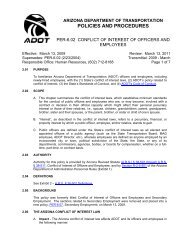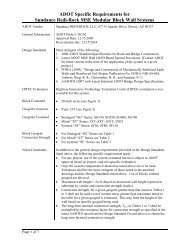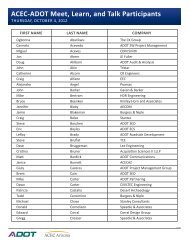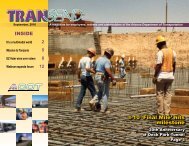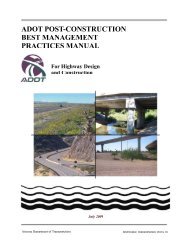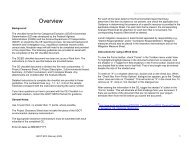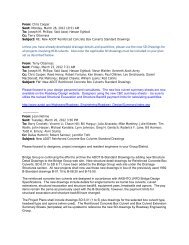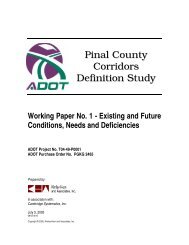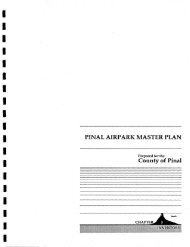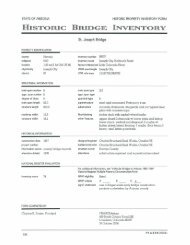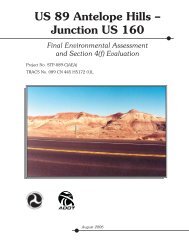I-10 Twin Peaks Traffic Interchange, Environmental Assessment
I-10 Twin Peaks Traffic Interchange, Environmental Assessment
I-10 Twin Peaks Traffic Interchange, Environmental Assessment
Create successful ePaper yourself
Turn your PDF publications into a flip-book with our unique Google optimized e-Paper software.
Affected Environment and <strong>Environmental</strong> Impacts October 2005<br />
agreement, as revised to address research design for treatment of archaeological<br />
resources, has been followed for this proposed project and would continue to be<br />
followed throughout the remainder of the project.<br />
In addition, ADOT interim procedures for treating the historic state highway<br />
system were developed in 2002. These procedures require the collection and<br />
documentation of information from the historic highway before construction that<br />
would impact these facilities.<br />
SHPO Concurrence<br />
SHPO has reviewed the cultural resources report prepared for this project and has<br />
concurred with all of the eligibility findings except that of the Tucson-Casa<br />
Grande Highway. SHPO stated that the segment of roadway within the project area<br />
contributed to its eligibility to the NRHP and that a project specific treatment plan<br />
would be needed (see letter in Appendix D).<br />
Conclusion<br />
The cultural resources report prepared for this proposed project recommended a<br />
determination of adverse effect because of proposed project impacts on two<br />
National Register-eligible properties: the Tucson-Casa Grande Highway (SR 84)<br />
and the Stewart Brickyard archaeological site. A strategy for mitigating adverse<br />
effects on these facilities was developed. Potential impacts on four other nearby<br />
National Register-eligible properties were evaluated and the project was<br />
determined to have no adverse effect on the historic qualities that make those<br />
resources eligible. Three other resources within the area of potential effect were<br />
recommended as ineligible for the National Register, and two other previously<br />
recorded properties had been destroyed.<br />
Socioeconomics<br />
Demographics<br />
According to the U.S. Census Bureau, the study area consisted of five census tracts<br />
within Pima County and the Town of Marana (Census Tracts 44.16, 44.20, 46.29,<br />
46.30, and 46.39), which represented a total 2000 population of 21,480. These<br />
census tracts are presented in Figure 4-5. Selected 2000 U.S. Census Bureau data<br />
from the five census tracts were compared to the same data for the Town of<br />
Marana, Pima County, and the State of Arizona in Table 4-<strong>10</strong>. Census data for<br />
these tracts is summarized in the following paragraphs.<br />
Census Tract 46.16 was the largest of the tracts, with a population of 8,841<br />
persons. Housing in this tract tended to be newer (94% constructed 1990 or after)<br />
and more frequently occupied by the owner (90.7%) when compared to the other<br />
tracts, the Town of Marana, Pima County, and Arizona. This tract also had a<br />
higher median family income ($60,172) when compared to the other tracts, the<br />
Town of Marana, Pima County, and Arizona. This census tract could be<br />
Interstate <strong>10</strong> <strong>Traffic</strong> <strong>Interchange</strong> at<br />
<strong>Twin</strong> <strong>Peaks</strong>/Linda Vista<br />
4-77<br />
Project No.: NH-0<strong>10</strong>-D (AIW)<br />
TRACS No.: <strong>10</strong> PM 236 H5838 01D



